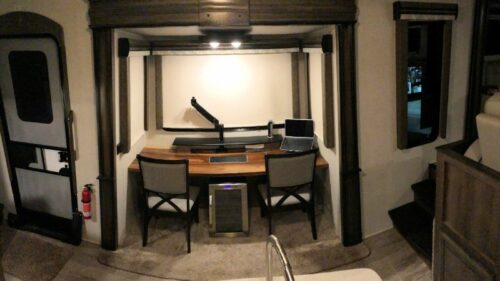Towing an RV isn’t easy.
You basically need a 4-year-degree in physics and the experience of a long-haul trucker to figure it all out.
But you don’t have either of those things (most likely), so how do you figure it out?
Well, you can read some of our excellent material on trailering and towing, both here and at AskTheRVEngineer.com.
You can review and play with our interactive towing calculators.
And you can read automotive manufacturers’ towing guides and ratings.
But if you’re pressed for time, you can just read this list. It’s a smattering of the crucial facts and numbers we think all RV owners should know about towing an RV.
Think we missed one? Contact us and let us know!
Drive safe out there!
30 Facts We Wish Everyone Knew About Towing an RV
- Practice driving in an empty parking lot before you hit the road!
- You may need a non-commercial CDL driver’s license if your motorhome weighs more than 26,000 lbs or your trailer weighs more than 10,000 lbs when loaded.
- You lose about 2% towing capacity for every 1,000 feet above sea level.
- Your engine loses about 3% power for every 1,000 feet above sea level.
- Hitch Weight (HW) and Rear Gross Axle Weight Rating (RGAWR) are the two capacities on your tow vehicle most likely to be overloaded when towing an RV camper. In layman’s terms, pay attention to your total payload!
- Most advertised maximum towing capacities require the use of a weight-distribution hitch for trailers over 5,000 lbs.
- Your vehicle’s practical towing limit is probably 50-80% of its advertised maximum capacity (use our calculators for more information).
- Weight-distribution hitches don’t just reduce the tongue weight! – they redistribute weight from the rear axle of the tow vehicle to the front axle of the tow vehicle and the axle[s] of the RV.
- Weight-distribution hitches add weight to your trailer axles, which can cause an overloaded condition!
- Don’t assume your hitch can tow up to your truck’s capacity! Confirm the hitch is the correct Class, not a smaller aftermarket hitch.
- Adjust your tow vehicle hitch height so the RV is towed while it’s level.
- Cross your safety chains underneath a travel trailer couple so it forms a “basket” if the coupler disengages.
- A travel trailer’s tongue weight should be 10-15% of its loaded weight.
- A 5th wheel’s pin weight should be 15-25% of its loaded weight.
- RV manufacturers’ tongue weights typically don’t include batteries or propane. Don’t trust them – measure your own tongue weight!
- Cargo Carrying Capacity (CCC) isn’t the same thing as Net Carrying Capacity (NCC). CCC is more conservative and doesn’t include the weight of fresh water, water heater tanks, and weight of propane in full tanks.
- RVs (especially motorhomes) rarely have the weight distributed equally side to side. Chances are, one side or corner of your RV is overloading the tire[s]!
- There are no MPG ratings on motorhomes. Trust the forums, not the salesman!
- Single-axle trailers are more maneuverable; double-axle trailers are safer on highways.
- The strength of a tire is based on its inflation pressure. Keep your tires inflated at all times!
- Motorhomes with short wheelbases and trailers with axles shifted forwards are very dangerous in crosswinds. They are prone to swaying and tipping.
- All states have restrictions on maximum rig length and maximum combined length. Certain roads may reduce these maximums. Know your route, and follow the law!
- Many states limit the maximum highway speed when towing to 55-65 mph.
- Use a 2-way radio and a spotter to help you when backing up. Scout out your backup route.
- Motorhome drivers should disconnect the dinghy before backing up.
- Use towing mirrors. You can cheap clip-ons, too.
- RV brakes and hubs need to be checked and maintained every year or every 10,000 miles, whichever comes first.
- Braking takes longer. Hit the brake sooner!
- Use engine braking (downshifting) to control descents on steep declines. Don’t just ride the brakes – they can overheat and lose their friction.
- If your speed drops below 45 mph on a highway, turn on your flashing hazard lights.
Andy Herrick is a blogging nerd, #8 Enneagram, wannabe bread baker, INTJ, RV industry professional, and small business entrepreneur. He can be found hanging out with his lovely wife and family, skiing, cycling, climbing, hiking, and convincing anyone who will listen why dogs aren’t really that great of pets. Also, he runs this website.
-
Andyhttps://changingears.com/author/andrew-herrick/
-
Andyhttps://changingears.com/author/andrew-herrick/
-
Andyhttps://changingears.com/author/andrew-herrick/
-
Andyhttps://changingears.com/author/andrew-herrick/










